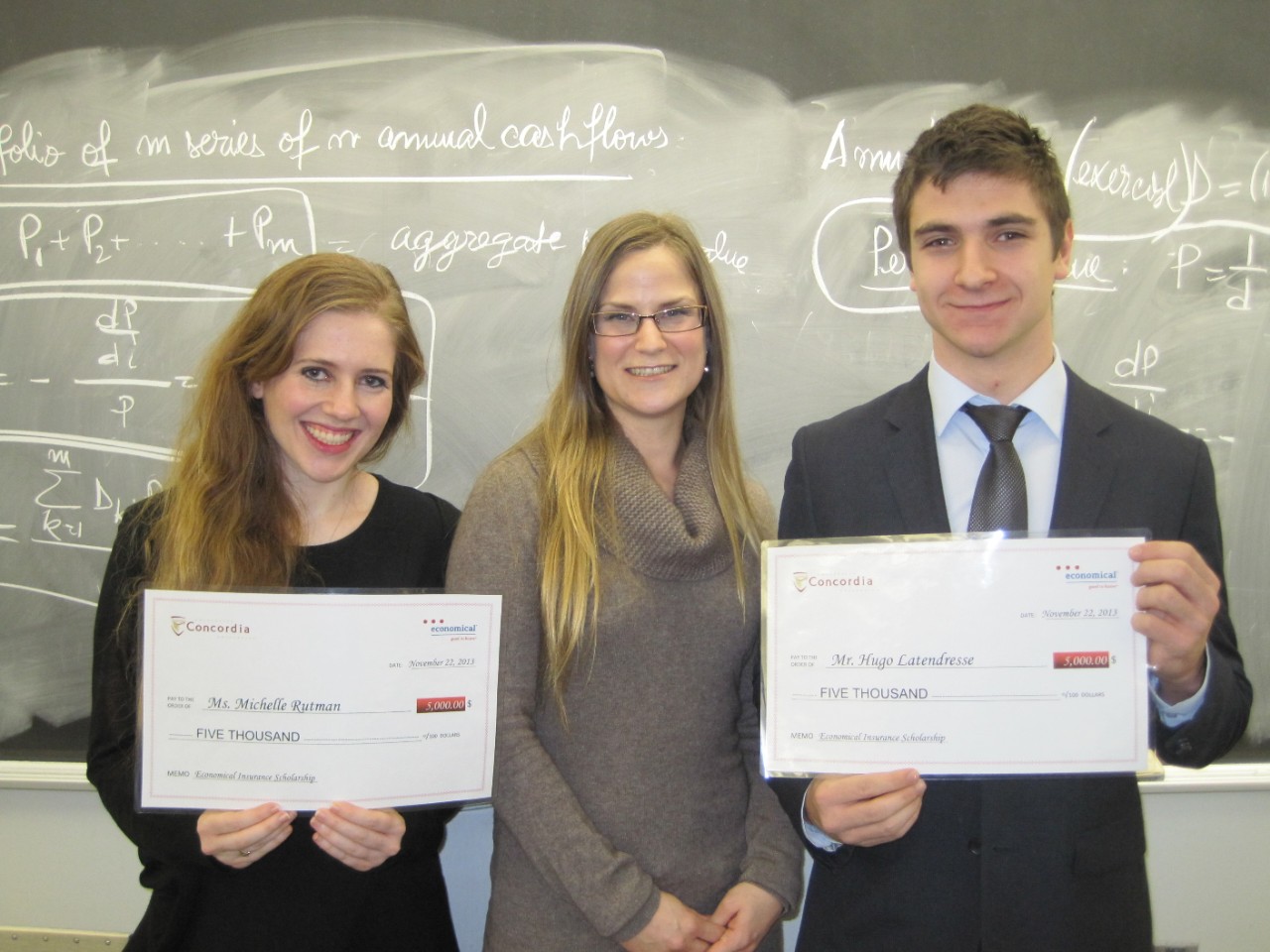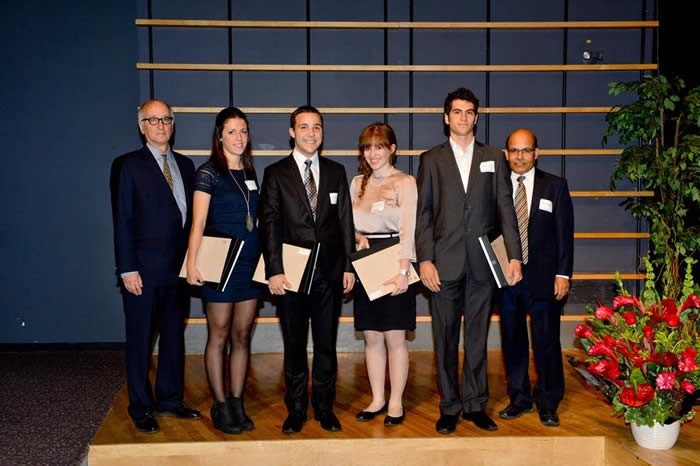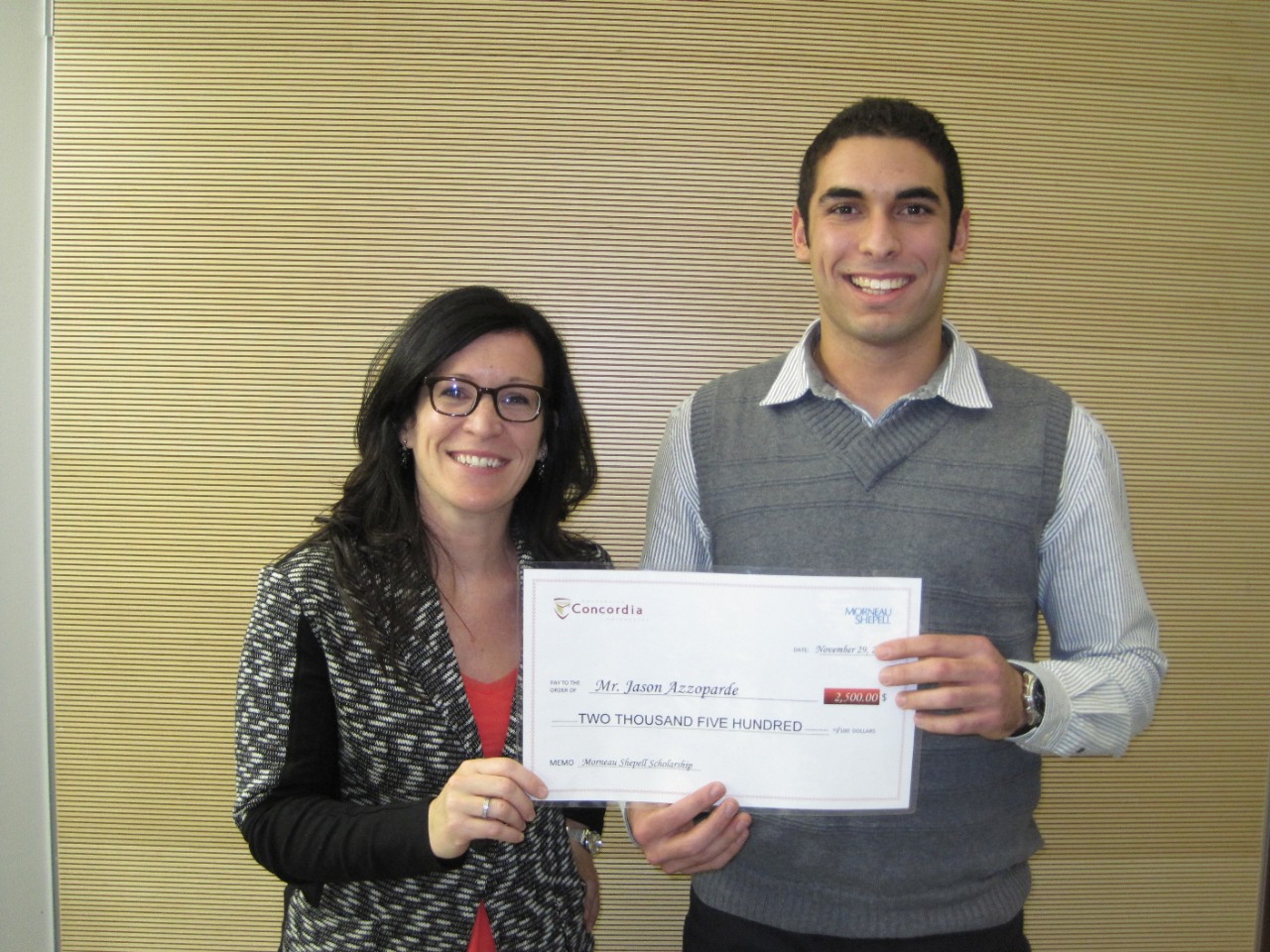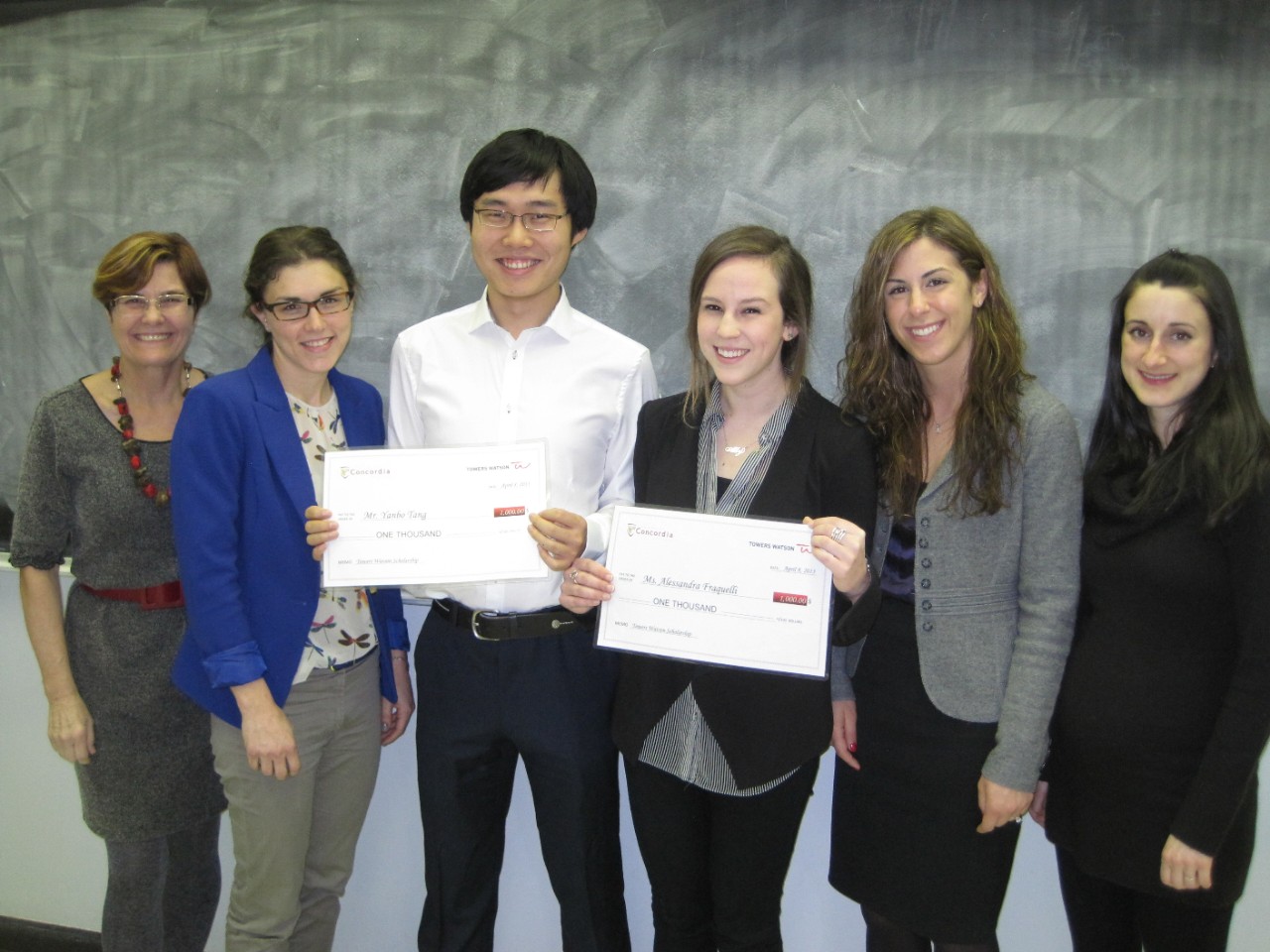Awards & Scholarships
Undergraduate level
This scholarship is awarded annually by the Actuarial Foundation to college seniors who have successfully completed at least one actuarial examination, rank in the top quartile of their class, and are nominated by a professor at their school. Each year, several stduents receive the $2,000 scholarships, established by the estate of Juhn Culver Wooddy, a distinguished actuary who set aside funds to provide scholarships to actuarial students.
For the last three years in a row, Concordia students were recipients of this prestigious scholarship:
2012
Jean Sebastien Cote (B.Sc. Specialization, Actu/Fina, Co-op)
2011
Matthieu Hubert (B.Sc. Specialization, Actu. Math)
2010
Jonathan Morin (B.Sc. Specialization, Actu/Fina, Co-op)
Established in 2013 through the generosity of Economical Insurance, in support of excellence in Actuarial Mathematics education. The Economical Insurance Scholarships are distinguished as the highest-value awards among undergraduate in-course scholarships for students pursuing a Bachelor/Baccalaureate degree in Actuarial Mathematics at Concordia University.
Starting with the 2013-14 academic year, two $5,000 Economical Insurance Scholarships will be awarded annually for the following 5 years.
Founded in 1871, Economical Insurance is a leading property and casualty insurance company in Canada, offering a wide range of personal, commercial, farm and surety products.
2013 Winners
- Hugo Latendresse (B.Sc. Honours, Actu. Math Co-op)
- Michelle Rutman (B.Sc. Specialization, Actu. Math Co-op)
 From left to right: Michelle Rutman, Véronique Ouellet (Economical Insurance), and Hugo Latendresse.
From left to right: Michelle Rutman, Véronique Ouellet (Economical Insurance), and Hugo Latendresse.
The Arts and Science Scholars list is completed every after the last annual GPA has been calculated. Students who are identified as Arts and Science Scholars are invited by the Dean of the Faculty of Arts and Science to an evening awards event during the following Fall term. For a student to be eligible as an Arts and Science Scholar, they must meet the following criteria:
- Be registered in an Arts and Science degree.
- Complete a minimum of 12 credits in both the Fall and Winter terms within the academic year.
- Have a GPA in the top 1% of their department (there is no minimum and the top GPAs will vary from year to year)
Arts & Science Scholars from our Department are as follows:
October 2012
 From left to right: Dr. Brian Lewis (Arts & Science Dean), Kimberly Dextras-Romagnino, Matthieu Hubert, Michelle Rutman, Nicolas Payeur, Dr. Yogendra P. Chaubey (Math & Stats Department Chair). Other award winners not present: Yanbo Tang, Geneviève Therrien. Photo by PBL Photography
From left to right: Dr. Brian Lewis (Arts & Science Dean), Kimberly Dextras-Romagnino, Matthieu Hubert, Michelle Rutman, Nicolas Payeur, Dr. Yogendra P. Chaubey (Math & Stats Department Chair). Other award winners not present: Yanbo Tang, Geneviève Therrien. Photo by PBL Photography
October 2010
David Mamane, Andrew Brulotte, Qiu Ying Xu, Matthieu Hubert, Francois Lamirande
October 2009
Emily Ditchburn-Trout, Olga Iacovlenco, François Lamirande, Davy Ly, Carol Neil
Established in 2010 through the benevolence of Morneau Shepell, the largest Canadian-based HR services company, this scholarship is intended to recognize and reward excellence in Actuarial Mathematics students who are entering their second year of studies.
2013 winner
Jason Azzoparde (B.Sc. Specialization, Actu/Math Co-op)
 From left to right: Lisa Bolduc (Morneau Shepell) and Jason Azzoparde.
From left to right: Lisa Bolduc (Morneau Shepell) and Jason Azzoparde.
2012 winner
Vincent Carrier-Côté (B.Sc. Specialization, Actu/Fina Co-op)
2011 winner
Steven Ma (B.Sc. Specialization, Actu/Fina Co-op)
These scholarships are funded thanks to the generosity of Towers Watson and awarded by the Department to eligible and most deserving 1st and 2nd year actuarial students.
April 2013
Yanbo Tang, Alessandra Fraquelli
 From left to right: Dr. Ewa Duma (Actuarial Program Director),
Geneviève Gauvin (Towers Watson), Yanbo Tang, Alessandra Fraquelli, Tina Nicolopoulos (Towers Watson) and Dr. Melina Mailhot.
From left to right: Dr. Ewa Duma (Actuarial Program Director),
Geneviève Gauvin (Towers Watson), Yanbo Tang, Alessandra Fraquelli, Tina Nicolopoulos (Towers Watson) and Dr. Melina Mailhot.
2011
Olivier Brown, Matthieu Hubert
2010
Andrew Brulotte, David Mamane
2009
Yadvinder Matharu, Vivian Lee
- Actuarial Foundation (John Culver Wooddy) scholarships;
- Economical Insurance scholarships;
- Faculty of Arts & Science scholars;
- Morneau Shepell scholarships;
- Towers Watson scholarships.
The Offices of the Vice-President, Research and Graduate Studies (OVPRGS) and Provost and Vice-President, Academic Affairs, are pleased to announce the continuation of the Concordia Undergraduate Student Research Awards (CUSRA) program for a sixth year. The CUSRA program provides funding to students in the fine arts, social sciences, humanities, engineering and computer science, business disciplines, and natural and health sciences. The goal of the awards is to stimulate interest in research, participatory research, or research-creation work that will complement undergraduate coursework and enhance preparation for graduate studies or research-related careers.
Funded by the ISM and the Centre de recherches mathématiques (CRM), the Undergraduate Summer Scholarships give undergraduate students the opportunity to acquire research experience in a university or industrial environment while offering young researchers the chance to gain experience in research supervision.
Description: ISM Summer scholarships are offered to undergraduate students in mathematics and statistics who are registered in one of the ISM member universities. They allow selected candidates to carry out research under the supervision of a postdoctoral fellow, a doctoral student or an assistant professor affiliated with one of the ISM member universities.
Learn more about the ISM's Undergraduate Summer Scholarships.
The Natural Sciences and Engineering Research Council of Canada (NSERC) is a federal agency responsible for promoting and supporting research in the natural sciences and engineering, other than the health sciences.
The objective of the Undergraduate Student Research Award (USRA) program is to provide research work experience for students to complement their degree program and encourage them to consider graduate studies and/or a research career.
Each summer, the Department of Mathematics and Statistics offers opportunities to Undergraduate students who wish to gain experience in research in Mathematics, Statistics, Actuarial, Financial Mathematics or other applied field. In these summer research projects, our students gain invaluable experience and training that transcends the standard curriculum. These experiences shape their interest in a future career and is viewed positively when applying to graduate programs.
Interested students should approach individual professors with enquiries. These positions are, generally, funded by the awards listed, but some of the projects may be funded by individual professors. Below you will also find a list of professors who are interested in directing undergraduate research projects with some topics of interest to them. If you have your own interest as well, do not hesitate to discuss it with our faculty members.
Email: abraham.boyarsky@concordia.ca
Invariant measures for a planar dynamical system
The existence of certain invariant measure is one the most important property that a chaotic system can possess as it describes the long term statistical behaviour of the dynamical system. In this project the student will be asked to do computational work to gain insight into the dynamics of the following two systems:
The logistic map is used to model populations that reproduce on a discrete time scale. If y_n represents a population of some species in the nth generation, then the population in the (n+1) st generation is given by
y_(n+1) = ky_n (1 - y_n ).
It is well known that the behaviour of orbits depends in a dramatic way on the growth parameter k and the seed y_0. One hidden assumption in the discrete logistic model is that the population in the (n+1) st generation depends only on the population in the nth generation. This is not always true. In the case that the population of the (n+1) st generation depends both on the n th and the (n -1) st generations, we have the delayed logistic map y_(n+1) = ky_n (1 - y_(n-1) ). To study this equations we introduce a new variable x_n = y_(n-1). We then rewrite the delayed logistic equations as the 2-dimensional system:
x_n = y_(n-1)
y_(n+1) = ky_n (1 - x_n )
We then interpret this model as an iteration of the 2 dimensional map:
F_k (x,y)=(y,ky(1-x))
The summer project is to study the long -term dynamics of F_k by computational means. First the student would search for invariant curves in the unit square, then estimate the distribution of orbit points on these curves.
Email: frederic.godin@concordia.ca
Stochastic volatility model
Modelling stock returns dynamics is an extremely important duty which is needed for option pricing, investment optimization, risk management and numerous other tasks in the financial industry. The stochastic volatility model allows incorporating a time-varying intensity of fluctuations of stock prices due to changing market conditions. These models allow representing numerous stylized facts of stock returns such as volatility clusters, the leverage effect, fat tail and skewness. However, estimating the parameters of such models is not straightforward due to the unobservability of the volatility. The objective of this summer research project is to obtain estimated parameters for a stochastic volatility model from a stock returns time series by applying filtering methods.
Electricity congestion price modelling
Within an electricity market, the electricity price varies across the different locations due to grid congestion i.e. limitation in transmission capacity. Risk related to price differentials between several grid nodes can be mitigated through the use of transmission related financial derivatives such as Forward Transmission Rights (FTR) in the PJM market in USA, or contract for difference (CfD) in the Nord Pool market in Scandinavia. Pricing such derivatives requires studying the statistical features of electricity price differentials which is the object of the current project. Times series methods will be applied to model the dynamics of electricity price differentials over a selected number of nodes in a chosen electricity market.
Email: pawel.gora@concordia.ca
Rings of Saturn
There exists a system of equations describing the dynamics of objects (large pieces of ice) in the rings of Saturn. It is a system of delayed difference equations, so it is very easy to implement on the computer. And this is all that is known about the system – computer simulations show that they really produce a ring of Saturn.
The first theoretical problem would be permanence, proving that the trajectories of the system stay bounded. Hopefully, careful examination of computer-modeled trajectories will lead to ideas useful for the proof.
Delayed logistic system
The behaviour of the logistic map x->ax(1-x), or x(n+1)=ax(n)(1-x(n)), is very well known and understood. It has been a topic of thousands of research articles. Almost nothing is known about the delayed logistic system x(n+1)=ax(n)(1-x(n-1)), where the next state depends on the two previous states. There is an old experimental paper showing some properties of this system. It would be very interesting to repeat their experiments on today’s computer and possibly discover more than it was possible in the 1980’s. Some theoretical facts could be proved on the basis of the experiments.
Email: lisa.kakinami@concordia.ca
Epidemiology and Applied Statistics
Broadly, my research aims to not only improve our understanding of the complex relationships between social determinants, environment, and behaviours to differentially affect obesity and cardiometabolic risk across the lifespan, but to also address important methodological and statistical limitations of the existing literature. Through a combination of data collection and statistical analysis of pre-existing large, longitudinal datasets, students are given opportunities to gain research experience and co-author manuscripts that are appropriate for their level of study and skills.
In particular, I currently have four specific areas of research:
Compensatory behaviours
Having a weight loss goal can provide people with structure and purpose, but failing to achieve this goal can also be stressful and harmful to their health. For successful weight loss, adherence to a strict diet is necessary, but difficult. For instance, a dieter may indulge at lunch with a slice of cake and rationalize that they’ll go to the gym later (an example of a compensatory behaviour). While going to the gym later may make the dieter feel less guilty, it is unclear how this compensatory behaviour may affect their weight loss goal. I am interested in learning whether these compensatory behaviours help or hinder a person’s ability to work toward attaining their goals, and whether they are helpful or harmful to a person’s mental and physical health.
Social and behavioural determinants of longitudinal health risk
Given that nearly ¼ of Canadian children are already overweight when they enter preschool, a better understanding of the early childhood environment is needed. In particular, as the household is the child’s first and primary social environment, the interplay of parenting style (the general parent-child interactions that can influence children’s behaviours) and children’s characteristics may be key to preventing excessive weight gain during childhood. I am interested in the bidirectional and interactive ways in which children’s characteristics may affect their social environment (and in turn), their obesity risk over time.
Growth models and proper identification of obesity during childhood
Compared to cross-sectional measures, longitudinal data contain additional information that allow for the separation of inter- and intra-individual effects over time. However, models to characterize growth in youth are traditionally created from cross-sectional measures. I am interested in modeling growth from longitudinal data, and validating these measures.
Reducing uncertainty in measurement methodology
Mixed research findings in the literature may, in large part, be due to misclassifications of exposure due to the evolving measurement methodologies. This is particularly relevant for the built environment and other longitudinal data that are continuously changing over time. I am interested in improving how we model the longitudinal changes of the neighbourhood environment by investigating the uncertainty of the available methodologies (such as geographical information systems and network distances).
Email: melina.mailhot@concordia.ca
Regulatory Capital Requirements
The objective of the research project will be to distinguish the choice between different risk measures to calculate regulatory capital requirements for insurance companies and financial institutions and provide information on covered risks, considering their dependence structure. The student will differentiate most common regulatory frameworks and compare metrics based on different approaches. Interest in Actuarial Mathematics and Risk Theory is an asset.
Numerical Applications of Optimal Reinsurance Treaties
Based on different risk distributions, the student will apply different optimization methods in order to compare quota-share ratios, retention rates and survival probabilities of several types of reinsurance treaties. The models will be standard models used in Actuarial Mathematics. Moreover, the student will work with distortion and utility functions. Interest in Actuarial Mathematics, Optimization and Risk Theory is an asset.
Numerical Application of Adequation Tests Based on Risk Measures
The student will program several adequation tests based on univariate and multivariate risk measures, such as VaR and TVaR, using simulated and real data sets. Those adequation tests will be applied for typical models used in the insurance industry. Interest in Actuarial Mathematics, Multivariate Modeling and Risk Theory is an asset.
Email: alina.stancu@concordia.ca
Planar convex bodies of constant angular width
Besides the disk, the Reuleaux triangle, and more generally, the Reuleaux polygons are known examples of bodies of constant width meaning that the minimal distance between any two parallel lines enclosing the body is constant, independent of the direction of the lines. A notion of angular width has been defined as follows. When C is a plane convex body and µ is an angle between zero and pi/2, the µ-diameter Dµ(C) (resp. the µ-width Wµ(C)) is defined as the length of the longest (resp. the shortest) chord of C which joins two rays of support enclosing an angle of µ. If µ is zero, we have precisely the ordinary diameter and width, and C is of constant width if and only if diameter and width are equal to each other. I would like to approach the study the sets of constant µ-width – defined as those for which Dµ = Wµ for convex sets enclosed by smooth curves. This will rely on studying the geometry of planar curves as seen in multidimensional calculus and can open up to other questions such as determine the greatest lower bound of the quotient D for µ =pi/2 to D for µ=0. (Victor Klee, Unsolved problems in intuitive geometry)
Models of hyperbolic geometry
In futile efforts to prove that Euclid’s parallel postulate follows from the previous axioms in Euclid’s Elements, several geometers were led to the discovery of different models of hyperbolic geometry. I propose to study some of the earlier models, and their connections, such as Klein’s and Beltrami’s models arriving to the more modern setting of Poincaré and the hyperboloid model in Minkowski geometry known from special relativity. The project can unravel the historical approach to the hyperbolic geometry or focus on the differential geometry, Gauss curvature, geodesics and such, depending on the interest of the student.
Dupin cyclides
Dupin cyclides are beautiful geometric objects that can be studied simply for their design and practical utility in building pipes and tubes. Engineers have done the latter! This project can be an excursion into using software to visualize Dupin cyclides and emphasize their properties and/or to understand their natural definition through conformal geometry as images of other objects by inversions with respect to a sphere.
- Concordia University undergraduate research awards (CUSRA);
- ISM undergraduate summer scholarships;
- NSERC undergraduate student research award (USRA).
Also visit Financial matters for information about awards and scholarships, loans and bursaries, work study program and small grants program for students at Concordia University.
Graduate level
Visit Financial matters for information about awards and scholarships, loans and bursaries, work study program and small grants program for students at Concordia University.
The Department of Mathematics & Statistics invites applications for the above bursary from students registered in a graduate or undergraduate program in the Department. The value of the award is approximately $ 2,000 in total. The number of awards and the amounts of the individual awards can vary from year to year.
Preference will be given to candidates who meet some or all of the following criteria:
- Having a proven interest in the teaching of mathematics at the pre-university level.
- Having returned to academic study after some interruption.
- Having overcome some particular handicap or obstacle, e.g. in academic background, physical health, financial security.
- Having been active as a volunteer in some social, political or professional organization.
To be eligible, the applicant must be registered for at least 12 credits in the given academic year.
Applications must include:
- the applicant's name, address, social insurance number;
- an up-to-date curriculum vitae;
- a statement of purpose indicating in what ways the applicant considers him- or herself worthy of the award (maximum 500 words);
- a list of courses the applicant is enrolled in during the current academic year;
- a list of any financial support that the applicant is receiving during the current academic year (scholarship, bursary, teaching assistant, etc.)
Applications are to be submitted to the Departmental Graduate Assistant. The deadline for applications is January 25.
Brenda Carter (1937-1989)
Brenda Carter was born in Battersea, a borough of London, England, on June 24, 1937. At the age of eleven, she won a scholarship to Grey Coat School, Westminster, and from there went to Salisbury Training College where she studied to become an elementary school teacher. She taught first at a school in the Scilly Islands, then moved to successively more responsible positions in schools in the County of Surrey. In 1972 she was appointed head teacher of Duppas Junior School in the Borough of Croydon, a low-achieving school situated in socially mixed area. By the time she resigned from this position for reasons of health in 1984, the standards of work by the children at the school in academic subjects, sports, arts and music, had risen to above average levels.
In 1984 Brenda Carter married and moved to Canada. Unable to teach for physical reasons, she enrolled in a master's program in the history of education at McGill University. At the time of her death on April 12, 1989, she had just embarked on writing up a study of one-room schoolhouses in the province of Québec at the beginning of this century.
Without formal mathematical qualifications, Brenda had a strong intuitive grasp of mathematical processes and procedures, and while not a doctrinaire feminist, she very much wanted many more women to find the keen pleasure in mathematics that she had found in it. The Memorial Scholarship was established by her husband, David Wheeler, a Professor of Mathematics at Concordia University from 1975 to 1990, and funded by the generous donations of friends and colleagues.
David Wheeler (1925-2000)
David Wheeler was born in UK on February 16, 1925. Through a career extending over 50 years and spent in three different countries (UK, USA, Canada), David Wheeler has made many important contributions to mathematical education at large. He was a professor at the Department of Mathematics and Statistics in Concordia University, where he taught mathematics and mathematics education courses. He was the founder and long time editor of the journal, For the Learning of Mathematics, one of the renown international journals in mathematics education.
David Wheeler died in Vancouver on October 7th, 2000. One of his colleagues, Mogens Niss, paid a tribute to him in these words: "David Wheeler was a mathematics educator who never in a fraction of a moment forgot that, from his perspective, mathematics education ought to be provided to human beings, in order to serve their needs as human beings, and with due respect being paid to how human beings are different, and to how they live, feel and think. Hence empathy, open- and broadmindedness, an unpompous sense of reality, and not the least silent humour, should permeate the way we deal with mathematics education. All of these permeated David himself. We have indeed lost a giant in mathematics education, and some of us a dear friend as well."
The Nick Herscovics Scholarship is awarded to a graduate student pursuing full-time studies in the area of Mathematics Education in the Department of Mathematics and Statistics. The amount of the scholarship is $900 awarded based on academic excellence, and can be held by the same person for a maximum of two years. The selection of the recipient is made by the Mathematics Education research group and the Department's Graduate Program Director, in consultation with other departmental members.
Application forms for the scholarship are available from, and are to be submitted to, the departmental Graduate Program Assistant. The deadline for receipt of applications is September 17.
